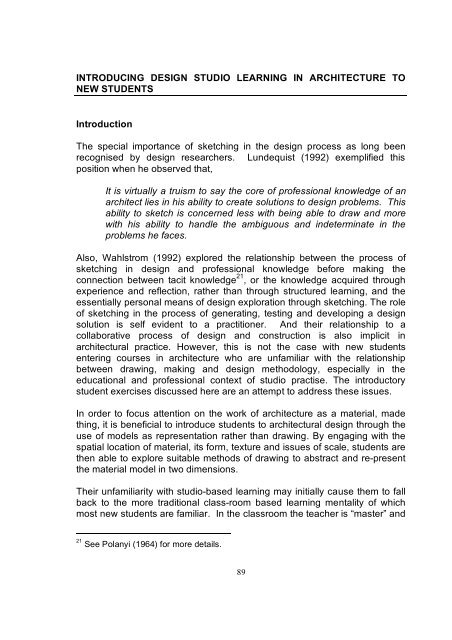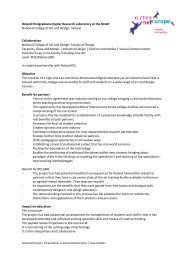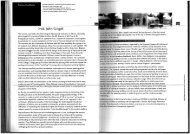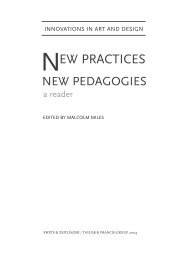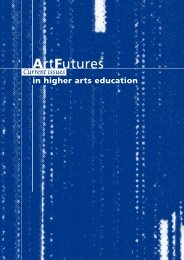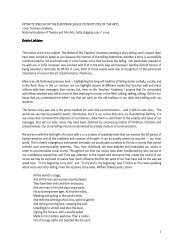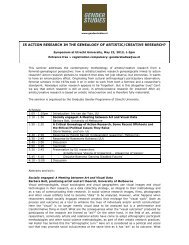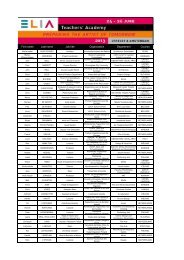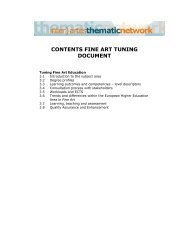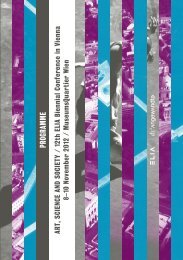- Page 1 and 2:
DESIGNingDESIGNEDUCATION d es i g n
- Page 3 and 4:
DESIGNTRAIN ORGANIZERS KTU KARADENI
- Page 5 and 6:
TABLE OF CONTENTS INTRODUCTION 5 KE
- Page 7 and 8:
phase. The first year education pro
- Page 9 and 10:
• Globalization versus Localizati
- Page 11 and 12:
Abstract In this keynote speech I w
- Page 13 and 14:
architecture moved towards particip
- Page 15 and 16:
different for its own sake; they pr
- Page 17 and 18:
Based on this view of architecture,
- Page 19 and 20:
In this brief, Derrida’s major di
- Page 21 and 22:
Concepts/words which designate diff
- Page 23 and 24:
answer all. I believe the question
- Page 25 and 26:
MacKinnon, D. W. (1962) The Persona
- Page 27 and 28:
A VISION FOR TRAINING DESIGN PROGRA
- Page 29 and 30:
ABSTRACT This study looks into the
- Page 31 and 32:
Training objectives • There are s
- Page 33 and 34:
Site supervision Working drawings &
- Page 35 and 36:
Method of Analysis: For each questi
- Page 43 and 44: THE DESIGN PROCESS Between imaginat
- Page 45 and 46: Results 1. If design incorporates b
- Page 47 and 48: (...)." 6 Idea and materialization
- Page 49 and 50: software applications. They determi
- Page 51 and 52: II. EVALUATION Description of the p
- Page 53 and 54: the interests of the students as de
- Page 55 and 56: Relationship between theory und pra
- Page 57 and 58: Hertzberger, H (2002), Creating Spa
- Page 59 and 60: ABSTRACT Education of architecture
- Page 61 and 62: FROM SOCIAL STUDIES CHAPTER III TO
- Page 63 and 64: - I cant draw, what am I going to d
- Page 65 and 66: This is worth thinking about becaus
- Page 67 and 68: - Avoiding fear It is important for
- Page 69 and 70: Life in Neverland… These pictures
- Page 71 and 72: As Krishnamurti indicated years ago
- Page 73 and 74: RESEARCH AND TRAINING IN THE FIELD:
- Page 75 and 76: Keywords: The Mausoleum of Belevi,
- Page 77 and 78: of stones, the reference points wer
- Page 79 and 80: so to speak, in the way, the points
- Page 81 and 82: Photogrammetry A further procedure
- Page 83 and 84: Although the areas recorded were in
- Page 85 and 86: study periods, which is usual, but
- Page 87 and 88: Keil J., (1933), 17. Vorläufiger B
- Page 89: ABSTRACT The design studio is centr
- Page 93 and 94: process of developing a suitable st
- Page 95 and 96: Figure 2 - Making a Wall (31 Januar
- Page 97 and 98: attempts to test the possibilities
- Page 99 and 100: Figure 5 - Final Study (14 February
- Page 101 and 102: Luis Manuel Fernandez Salido Gradua
- Page 103 and 104: ABSTRACT Introduction Analysis of f
- Page 105 and 106: ANALYSIS OF FORMS We would like to
- Page 107 and 108: 3rd Design culture The third aim pr
- Page 109 and 110: 3. To manifest and communicate the
- Page 111 and 112: 4. End of the process In order to e
- Page 113 and 114: the graphic skill. This is the reas
- Page 115 and 116: STARTING DESIGN EDUCATION: “BASIC
- Page 117 and 118: such as harmony and contrast. In co
- Page 119 and 120: works in Basic Design course and ke
- Page 121 and 122: Figure 10. Büra Pars, Exercise on
- Page 123 and 124: can I do?” as the classes advance
- Page 125 and 126: 124
- Page 127 and 128: ABSTRACT “To be playful and serio
- Page 129 and 130: what our intention is in the design
- Page 131 and 132: ehind the chosen contract, but the
- Page 133 and 134: Figure 1. student photograph - a li
- Page 135 and 136: Figure 4. student drawing - superim
- Page 137 and 138: Figure 6. student refinements - edi
- Page 139 and 140: ARCHITECTURE & PHILOSOPHY: THOUGHTS
- Page 141 and 142:
The students explore the revolution
- Page 143 and 144:
years demonstrate a proclivity to a
- Page 145 and 146:
expound on concepts of contemporary
- Page 147 and 148:
knowledge in architecture. He requi
- Page 149 and 150:
AN EMBODIED APPROACH TO LEARNING AT
- Page 151 and 152:
ABSTRACT The challenge of teaching
- Page 153 and 154:
our prior experiences, beliefs and
- Page 155 and 156:
Starr-Glass (2002) has a great anal
- Page 157 and 158:
Connection Bourdieu (2000) said tha
- Page 159 and 160:
every day, describing what happened
- Page 161 and 162:
MANFREDO TAFURI, AND JEAN PAUL SART
- Page 163 and 164:
MANFREDO TAFURI, AND JEAN PAUL SART
- Page 165 and 166:
them, absorb them, to become a “g
- Page 167 and 168:
ather we create a medium for oursel
- Page 169 and 170:
A second look at Ruskin’s initial
- Page 171 and 172:
As a new conscious attitude toward
- Page 173 and 174:
THINKING CONSTRUCTION AS DESIGN AND
- Page 175 and 176:
ABSTRACT Introduction. The main edu
- Page 177 and 178:
THINKING CONSTRUCTION AS DESIGN AND
- Page 179 and 180:
development of form disregarding te
- Page 181 and 182:
problem was that students’ knowle
- Page 183 and 184:
thought developed as a tool to resp
- Page 185 and 186:
ABSTRACT The studio experiences in
- Page 187 and 188:
THE FIRST PROJECT (STUDIO) EXPERIEN
- Page 189 and 190:
environment of the house to a small
- Page 191 and 192:
I. Step In this step, the students
- Page 193 and 194:
II. STEP DRAWINGS AND MODEL SAMPLES
- Page 195 and 196:
Betül Maden (Student) Merve Yava
- Page 197 and 198:
expected the get as much informatio
- Page 199 and 200:
Architecture, 3. International Cong
- Page 201 and 202:
ABSTRACT Introduction: Researchers
- Page 203 and 204:
engagement, haptic engagement, ment
- Page 205 and 206:
Categories that emerge from the ens
- Page 207 and 208:
Design is also a form of creative p
- Page 209 and 210:
Hoare, Carol (Editor) Handbook of A
- Page 211 and 212:
Didem BEDÜK TUNCEL • Ph.D. in In
- Page 213 and 214:
As can be seen in the student proje
- Page 215 and 216:
under the title of user needs. In t
- Page 217 and 218:
space. It is obvious that living in
- Page 219 and 220:
see that several socio-cultural and
- Page 221 and 222:
Figure 3: Ayda Gelgör, student pro
- Page 223 and 224:
REFERENCES Altınok, H.Z. , 2007. T
- Page 225 and 226:
THE COTTBUS EXPERIMENT THREE FIELDS
- Page 227 and 228:
Skills and Knowledge We would like
- Page 229 and 230:
“The architect should be equipped
- Page 231 and 232:
ability to share his competencies w
- Page 233 and 234:
the creative process itself. This l
- Page 235 and 236:
But how to structure the curriculum
- Page 237 and 238:
The first field of competencies - S
- Page 239 and 240:
the student to realise his personal
- Page 241 and 242:
EXPERIMENTATION VERSUS READY-KNOWLE
- Page 243 and 244:
own thinking way. Intuitive way of
- Page 245 and 246:
of all concepts with intuition and
- Page 247 and 248:
of main aim is uncovering the secon
- Page 249 and 250:
Figure 3. Examples of exploration o
- Page 251 and 252:
1. Aydınlı Semra, (2001), Mimarl
- Page 253 and 254:
ABSTRACT Thinking and creativity ar
- Page 255 and 256:
Taking a certain education model as
- Page 257 and 258:
CONCRETE ……………… ..… .
- Page 259 and 260:
Table 2. Encounter Abstract Concret
- Page 261 and 262:
Table 5. Meeting Abstract Student :
- Page 263 and 264:
FROM TRADITIONAL TO MODERN; METHODO
- Page 265 and 266:
The desired result is to provide co
- Page 267 and 268:
In the coverage of Planning 1 Studi
- Page 269 and 270:
• Quarter concept planning and de
- Page 271 and 272:
Figure 3: Identification Process of
- Page 273 and 274:
Figure 7: Synthesis Figure 8: Zonni
- Page 275 and 276:
carry out a design study relating t
- Page 277 and 278:
students on the subject of design b
- Page 279 and 280:
ABSTRACT The theoretical framework
- Page 281 and 282:
THE DANCE OF DESIGN AND SCIENCE IN
- Page 283 and 284:
Second motivation generated the arc
- Page 285 and 286:
Bilgi Denel and A Methodology for B
- Page 287 and 288:
one fact well by manipulating it, w
- Page 289 and 290:
explanation of design activity in 1
- Page 291 and 292:
ABSTRACT Basic design education is
- Page 293 and 294:
the author found two dimensional ge
- Page 295 and 296:
For the second task, drawing differ
- Page 297 and 298:
etween basic design success and rem
- Page 299 and 300:
Figure 5: An example of a design al


